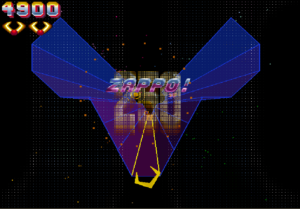Tempest 2000
 I had intended to get back into Etherlords his weekend, but I just didn’t feel like it. Sometimes the brain wants a rest. And so I choose a game that the spinal cord can play by itself. Tempest is of course the original fast-paced shoot-em-up-in-a-tube, and Tempest 2000 is its by-now-also-retro remake with a toe-tapping techno soundtrack (played directly off the CD, olde-style).
I had intended to get back into Etherlords his weekend, but I just didn’t feel like it. Sometimes the brain wants a rest. And so I choose a game that the spinal cord can play by itself. Tempest is of course the original fast-paced shoot-em-up-in-a-tube, and Tempest 2000 is its by-now-also-retro remake with a toe-tapping techno soundtrack (played directly off the CD, olde-style).
There was a brief but substantial wave of these remakes of “classic” arcade games around the turn of the millennium: re-imaginings that took advantage of 3D hardware and new innovations in game design, or, to put it another way, attempts on the part of the new IP holders to cash in on nostalgia by bolting on texture-mapping and power-ups and rudimentary storylines. Tempest 2000 wasn’t really part of this trend, having come a few years too early — despite the name, it was originally released on the Atari Jaguar in 1994, and its PC port in 1996. Because of this, it doesn’t quite fit the template. It has the powerups, sure, but it thankfully avoids spoiling the abstract purity of the original with a storyline. And (outside of the bonus levels) it doesn’t have texture-mapping — it uses Tron-esque solid-filled polygons instead of the bare wireframe of the original, but that’s as far as it goes.
Instead, the graphics technology it wants to show off is particle effects — there’s a constant spray of rainbow confetti in the background, and there’s often enough explosion debris and floating word residue on the screen that it’s hard to see what you’re doing. Seriously, check out the screenshot. The thumbnail doesn’t do it justice. It all reminds me of the complaints about Space Giraffe, a game which I’ve never played and don’t know much else about. Well, as you may already know, but I did not, Space Giraffe is in fact a remake of Tempest 2000 by the same designer. I’ve been vaguely aware of Jeff Minter since Llamatron, but somehow didn’t notice that he was involved with this game, probably because it doesn’t have some kind of quadruped in its title.
Filtering out the visual noise is of course a skill that you can learn. Some have gone so far as to call it the fundamental videogame skill. And this is very much a skill-based game. The day’s practice has seen me make substantial improvement already — I can now consistently clear level 20 (out of 100) from a standing start — but it’s not because I’ve made discoveries or varied my tactics or anything like that. I’ve been hesitant to start games of this sort since starting this blog, because they provide no guarantee that I’ll ever be able to complete them. With an RPG, there’s always the option of level-grinding until it’s easy. With a FPS, you can generally get through the hard bits by saving more often. With an adventure, there’s always walkthroughs, or, failing that, reverse-engineering the data files. But if a level in a twitch game is beyond you, there’s not much you can do. Tempest 2000 effectively provides infinite continues — within a session, you can always start a new game at or near the level you died. I expect I’ll be needing that.
 Comments(2)
Comments(2)